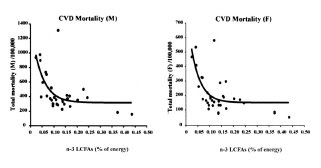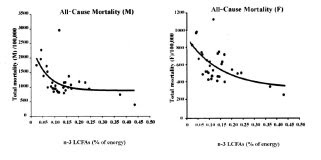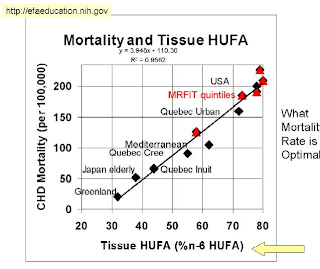One of the interesting things about the modern Inuit diet is it's most often a combination of Western and traditional foods. For example, they typically use white flour and sugar, but continue to eat seal oil and fish. Both seal oil and fish are a concentrated source of long-chain omega-3 (n-3) fatty acids.The 'paradox' makes much more sense to me now that I've seen this:
 It's from the same paper as the graphs in the last post. Note that it doesn't take much n-3 to get you to the asymptote. Here's another one that might interest you:
It's from the same paper as the graphs in the last post. Note that it doesn't take much n-3 to get you to the asymptote. Here's another one that might interest you: The finding in this graph is supported by the Lyon diet heart study, which I'll describe below. One more graph from a presentation by Dr. Lands, since I began by talking about the Inuit:
The finding in this graph is supported by the Lyon diet heart study, which I'll describe below. One more graph from a presentation by Dr. Lands, since I began by talking about the Inuit:
Cardiovascular disease mortality tracks well with the n-6 content of blood plasma, both across populations and within them. You can see modern Quebec Inuit have the same low rate of CVD mortality as the Japanese. The five red triangles are from MRFIT, a large American intervention trial. They represent the study participants divided into five groups based on their plasma n-6. Note that the average percentage of n-6 fatty acids is very high, even though the trial occurred in the 1970s! Since n-3 and n-6 fats compete for space in human tissue, it makes sense that the Inuit are protected from CVD by their high n-3 intake. [Update: I don't read too much into this graph because there are so may confounding variables. It's an interesting observation, but take it with a grain of salt.. SJG 2011].
Now for a little mechanism. Dr. Lands' hypothesis is that a high n-6 intake promotes a general state of inflammation in the body. The term 'inflammation' refers to the chronic activation of the innate immune system. The reason is that n-3 and n-6 fats are precursors to longer-chain signaling molecules called eicosanoids. In a nutshell, eicosanoids produced from n-6 fatty acids are more inflammatory and promote thrombosis (clotting) more than those produced from n-3 fatty acids. Dr. Lands is in a position to know this, since he was one of the main researchers involved in discovering these mechanisms. He points out that taking aspirin to 'thin' the blood and reduce inflammation (by inhibiting inflammatory eicosanoids) basically puts a band-aid over the problem caused by excess n-6 fats to begin with. [Update- this mechanism turns out not to be so straightforward. SJG 2011]
The Lyon Diet Heart Study assessed the effect of n-3 fat supplementation on CVD risk. The four-year intervention involved a number of diet changes designed to mimic the American Heart Association's concept of a "Mediterranean diet". The participants were counseled to eat a special margarine that was high in n-3 from alpha-linolenic acid. Overall PUFA intake decreased, mostly due to n-6 reduction, and n-3 intake increased relative to controls. The intervention caused a 70% reduction in cardiac mortality and a large reduction in all-cause mortality, a smashing success by any measure.
In a large five-year intervention trial in Japan, JELIS, patients who took EPA (a long-chain n-3 fatty acid) plus statins had 19% fewer cardiac events than patients taking statins alone. I don't know why you would give EPA by itself when it occurs with DHA and alpha-linolenic acid in nature, but it did nevertheless have a significant effect. Keep in mind that this trial was in Japan, where they already have a much better n-6/n-3 ratio than in Western nations.
In my opinion, what all the data (including a lot that I haven't included) point to is that a good n-6 to n-3 ratio may be important for vibrant health and proper development. In the next post, I'll talk about practical considerations for achieving a good ratio.